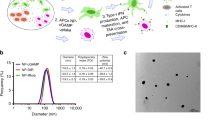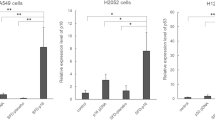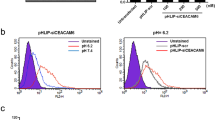Abstract
Growth inhibition of established tumor metastases in the lungs poses a difficult challenge for most clinical settings in spite of extensive multi-modality approaches. Aerosol delivery of drugs and genes holds promise for the treatment of disseminated lung metastases, since aerosol delivery can target the lungs specifically and uniformly. We previously demonstrated that aerosol delivery of dilauroylphosphatidylcholine liposome formulation of 9-nitrocamptothecin (9NC-DLPC) inhibits B16-F10 melanoma lung metastases. Aerosol delivery of polyethleneimine-p53 DNA (PEI-p53) complexes results in a similar anti-tumor effect in the B16-F10 model. In both these previous studies, the protocols were designed to inhibit development of lung metastases. In this study we demonstrate, using the B16-F10 melanoma lung metastasis model, that sequential aerosol delivery of PEI-p53 and 9NC-DLPC acts additively to inhibit growth of established B16-F10 tumor metastases in the lungs. Mice injected with B16-F10 cells and treated with a combination of 9NC-DLPC (twice weekly) and PEI-p53 (once weekly) aerosol complexes starting on day 11 after tumor inoculation, exhibited a highly significant (P < 0.01) reduction in the number of visible tumor foci as compared with untreated mice or mice treated with either single agent alone, or with a combination of 9NC and a control plasmid. There was a highly significant reduction in the tumor burden, as well as the lung weights for the 9NC and p53 combination group (P < 0.001 as compared with other groups). Moreover, the doses of p53 gene and 9NC in the combination group were reduced at least two-fold as compared with our previous single agent studies, but still achieved significant tumor inhibition. Furthermore, the sequential aerosol delivery of p53 and 9NC lead to a 30–40% increase in the mean survival time of these mice, as compared with animals in different control groups. The data suggest that the combination of 9NC and p53 gene delivered by aerosol is an attractive strategy for growth inhibition of established tumor metastases in the lungs.
This is a preview of subscription content, access via your institution
Access options
Subscribe to this journal
Receive 12 print issues and online access
$259.00 per year
only $21.58 per issue
Buy this article
- Purchase on Springer Link
- Instant access to full article PDF
Prices may be subject to local taxes which are calculated during checkout



Similar content being viewed by others
References
Lowe S.W. et al. P53 status and the efficacy of cancer therapy in vivo Science 1994 266: 807 807
Fujiwara T. et al. A retroviral wild-type p53 expression vector penetrates human lung cancer spheroids and inhibits growth by inducing apoptosis Cancer Res 1993 53: 4129 4129
Horio Y. et al. Synergistic effects of adenovirus expressing wild-type p53 on chemosensitivity of non-small cell lung cancer cells Cancer Gene Ther 2000 7: 537 537
Koshkina N.V. et al. Distribution of camptothecin after delivery as a liposome aerosol or following intramuscular injection in mice Cancer Chemother Pharmacol 1999 44: 187 187
Thierry A.R. et al. Systemic gene therapy: biodistribution and long-term expression of a transgene in mice Proc Natl Acad Sci USA 1995 92: 9742 9742
Gautam A., Densmore C.L., Xu B., Waldrep J.C. . Enhanced gene expression in mouse lung after PEI-DNA aerosol delivery Mol Ther 2000 2: 63 63
Gautam A., Densmore C.L., Waldrep J.C. . Pulmonary cytokine responses associated with PEI-DNA aerosol delivery Gene Therapy 2001 8: 254 254
Gautam A., Densmore C.L., Waldrep J.C. . Inhibition of experimental lung metastasis by aerosol delivery of PEI-p53 complexes Mol Ther 2000 2: 318 318
Densmore C.L. et al. Growth inhibition of established human osteosarcoma lung metastases in mice by aerosol delivery of PEI-p53 complexes Cancer Gene Ther 2001 8: 619 619
Koshkina N.V. et al. 9-Nitrocamptothecin liposome aerosol treatment of melanoma and osteosarcoma lung metastases in mice Clin Cancer Res 2000 6: 2876 2876
Knight V. et al. Anticancer effect of 9-nitrocamptothecin liposome aerosol on human cancer xenografts in nude mice Cancer Chemother Pharmacol 1999 44: 177 177
Koshkina N.V. et al. Improved respiratory delivery of the anticancer drugs, camptothecin and paclitaxel, with 5% CO2-enriched air: pharmacokinetic studies Cancer Chemother Pharmacol 2001 47: 451 451
Gautam A. et al. Improved respiratory delivery of the anticancer drugs, camptothecin and paclitaxel, with 5% CO2-enriched air: pharmacokinetic studies Cancer Gene Ther 2002 9: 28 28
Murren J.R. et al. Dose-escalation and pharmacodynamic study of topotecan in combination with cyclophosphamide in patients with refractory cancer J Clin Oncol 1997 15: 148 148
Lebedeva S. et al. Tumor suppression and therapy sensitization of localized and metastatic breast cancer by adenovirus p53 Hum Gene Ther 2001 12: 763 763
Cummings J., Smyth J.F. . DNA topoisomerase I and II as targets for rational design of new anticancer drugs Ann Oncol 1993 4: 533 533
Liu W., Zhang R. . Upregulation of p21WAF1/CIP1 in human breast cancer cell lines MCF-7 and MDA-MB-468 undergoing apoptosis induced by natural product anticancer drugs 10-hydroxycamptothecin and camptothecin through p53-dependent and independent pathways Int J Oncol 1998 12: 793 793
Nieves-Neira W., Pommier Y.A. . Apoptotic response to camptothecin and-hydroxystaurosporine (UCN-01) in the 8 human breast cancer cell lines of the NCI Anticancer Drug Screen: multifactorial relationships with topoisomerase I, protein kinase C, Bcl-2, p53, MDM-2 and caspase pathways Int J Cancer 1999 82: 396 396
Kalechman Y., Strassman G., Albek M., Sredni B. . Up-regulation by ammonium trichloro(dioxoethylene-0,0′) tellurate (AS101) of Fas/Apo-1 expression on B16 melanoma cells: implications for the antitumor effects of AS101 J Immunol 1998 161: 3536 3536
Hanahan D., Folkman J. . Patterns and emerging mechanisms of the angiogenic switch during tumorigenesis Cell 1996 86: 353 353
Clements M.K., Jones C.B., Cumming M., Daoud S.S. . Antiangiogenic potential of camptothecin and topotecan Cancer Chemother Pharmacol 1999 44: 411 411
O'Leary J.J. et al. Antiangiogenic effects of camptothecin analogues-amino-20(S)-camptothecin, topotecan, and CPT-11 studied in the mouse cornea model Clin Cancer Res 1999 5: 181 181
Zhang L. et al. Wild-type p53 suppresses angiogenesis in human leiomyosarcoma and synovial sarcoma by transcriptional suppression of vascular endothelial growth factor expression Cancer Res 2000 60: 3655 3655
Dameron K.M., Volpert O.V., Tainsky M.A., Bouck N. . Control of angiogenesis in fibroblasts by p53 regulation of thrombospondin-1 Science 1994 265: 1582 1582
Fujiwara T. et al. Induction of chemosensitivity in human lung cancer cells in vivo by adenovirus-mediated transfer of the wild-type p53 gene Cancer Res 1994 54: 2287 2287
Nemunaitis J.A. et al. Adenovirus-mediated p53 gene transfer in sequence with cisplatin to tumors of patients with non-small-cell lung cancer J Clin Oncol 2000 18: 609 609
Swisher S.G. et al. Adenovirus-mediated p53 gene transfer in advanced non-small-cell lung cancer J Natl Cancer Inst 1999 91: 763 763
Acknowledgements
The research was funded by the Clayton Foundation for Research, Houston TX. AG and CLD were also supported, in part, by an Advanced Technology Program Grant from the Texas Higher Education Coordinating Board (No. 004949-0129-1999 to C Densmore).
Author information
Authors and Affiliations
Rights and permissions
About this article
Cite this article
Gautam, A., Waldrep, J., Densmore, C. et al. Growth inhibition of established B16-F10 lung metastases by sequential aerosol delivery of p53 gene and 9-nitrocamptothecin. Gene Ther 9, 353–357 (2002). https://doi.org/10.1038/sj.gt.3301662
Received:
Accepted:
Published:
Issue Date:
DOI: https://doi.org/10.1038/sj.gt.3301662
Keywords
This article is cited by
-
Quantitative evaluation of the immunodeficiency of a mouse strain by tumor engraftments
Journal of Hematology & Oncology (2015)
-
Is an Alternative Drug Delivery System Needed for Docetaxel? The Role of Controlling Epimerization in Formulations and Beyond
Pharmaceutical Research (2013)
-
Therapeutic Liposomal Dry Powder Inhalation Aerosols for Targeted Lung Delivery
Lung (2012)
-
Formulation and Evaluation of Aerosolized Celecoxib for the Treatment of Lung Cancer
Pharmaceutical Research (2005)



